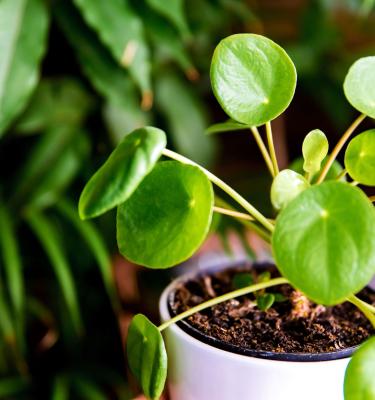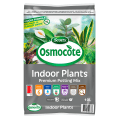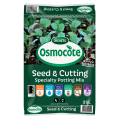

How to care for Chinese money plant
With its iconic round leaves and vibrant green colour, the Chinese money plant (Pilea peperomioides) has become a favourite among indoor gardeners. Easy to care for and forgiving of occasional missed waterings, this resilient plant is perfect for Australian homes.
Whether you're looking to keep your plant thriving or propagate it to share with friends, here's everything you need to know about the Chinese money plant.

Getting to know the Chinese money plant
Native to China’s Yunnan and Sichuan provinces, the Pilea peperomioides is a member of the nettle family. Known for its sleek, succulent-like stems and round leaves, the plant’s appearance evolves as it grows. Over time, its central stem becomes woodier at the base, giving it the look of a small indoor tree. In early spring, small white Chinese money plant flowers may appear and last for several weeks.
The Chinese money plant typically grows up to 60 cm tall and thrives in well-lit indoor spaces. Also known as the “Pancake plant” for its flat, round leaves, this plant is a decorative addition to any home.
How to care for a Chinese money plant
The perfect indoor plant
If you’ve fallen for the charm of the Chinese money plant, here’s a crucial tip: keep it as an indoor plant. This tropical beauty doesn’t tolerate cold temperatures well, making Australian interiors a perfect fit. You can move it outside during summer, but it thrives best in living rooms or offices year-round.
Best plant companions for your Chinese money plant
The Chinese money plant shines as a standalone feature in a stylish pot or as part of an indoor succulent arrangement. Pairing it with other low-maintenance plants can create a trendy indoor garden while also improving air quality.
For variety, consider Pilea depressa, a trailing relative of the Chinese money plant, which adds cascading greenery to shelves and hanging baskets. Or for a fresh, modern look, combine it with other low-maintenance plants like succulents or ferns. Succulents and the Chinese money plant share similar light and watering requirements, making them perfect companions. Together, they create a vibrant indoor garden that’s easy to care for and adds natural beauty to any space.
When to repot your Chinese money plant
Repot your Chinese money plant every two to three years or sooner if its roots start emerging from the pot. If you’ve just bought one, consider repotting it straight away if the roots look cramped.
Chinese money plant propagation
Want to share your plant with friends or family? Good news: propagating the Chinese money plant is incredibly simple. Look for baby plants (offsets) growing at the base of the main stem and wait until they are about 6–7 cm tall.
How to propagate Chinese money plant: Two propagation methods
Direct soil planting:
-
Use a sterile cutting tool to carefully separate the offset.
-
Plant it in a small pot filled with propagation soil mix.
-
Water lightly to encourage rooting without risking rot.
Water propagation:
-
Place the offset in a glass of water, ensuring the base is submerged.
-
Change the water every two days.
-
Once roots have developed, transfer the plant to a pot filled with soil.

Watering and caring for your Chinese money plant
To keep your Chinese money plant healthy and thriving, it only needs two key things: the right amount of light and proper watering.
How often to water Chinese money plants
-
Summer: Water twice a week, allowing the soil to dry slightly between waterings.
-
Winter: Water less frequently, about once every two weeks, to prevent overwatering.
If unsure, check the soil – the top 2.5-5cm of potting mix should dry out between each watering. Always ensure excess water is drained away, as standing water can cause root rot. If you notice blackened leaves, this is a sign of overwatering.
Tips for optimal Chinese money plant care
-
Rotate the pot every few weeks to prevent the plant from leaning toward the light source.
-
For a bushier plant, pinch off the growing tips to encourage branching.
-
If leaves turn yellow or appear smaller, apply a slow-release fertiliser once a year or use a liquid fertiliser weekly during the growing season.
Common pests and problems for Chinese money plants
The Chinese money plant is relatively pest-resistant but can occasionally be targeted by red spider mites. These thrive in dry environments. Mist the plant with non-calcareous water to increase humidity and prevent infestations. For severe cases, use a natural miticide spray.
Key tips for success when growing Chinese money plants
-
Light: Bright, indirect light is ideal. Move the plant closer to windows in winter if it looks droopy.
-
Watering: Let the soil dry slightly between waterings and avoid waterlogged conditions.
-
Propagation: Share your plant by propagating offsets in soil or water.
-
Fertilising: Feed regularly during the growing season to maintain lush, green growth.
-
Pest control: Mist the plant occasionally to keep spider mites away.
By following these simple tips, your Chinese money plant will thrive and bring joy to your indoor space for years to come.
Frequently asked questions about Chinese money plants
How often should I water my Chinese money plant?
Water your Chinese money plant twice a week in summer and once every two weeks in winter, ensuring the soil dries slightly between waterings.
What’s the best way to propagate a Chinese money plant?
You can propagate offsets either directly in soil or in water. Both methods are easy and effective, but water propagation allows you to watch the roots grow.
Where should I place my Chinese money plant?
Choose a spot with bright, indirect light and avoid direct sun, which can scorch its leaves.





